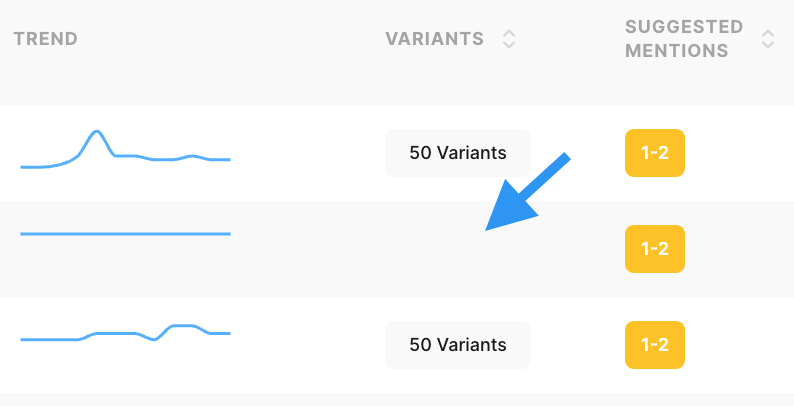Here are some tips on incorporating variants into your content strategy.
If there are no variants that entry is left blank
Variants are topics that represent ideas for integrating concepts into content. They use the topic as a substring of the variant. So by adding – prefixes, suffixes, and or preceding or trailing words variants are developed.

In cases where there are no variants, we leave the entry blank.
Variants side panel
If you included an optional URL, the variant side-panel shows the number of main topic mentions in addition to the suggested mentions.

By default they’re sorted by volume, but you can change that if you wish. That won’t affect the main panel though.
How variants work
The topic and keyword variants that MarketMuse displays with this technology align the most important user intent profiles to common variant terms. The list of variants shown by MarketMuse communicates the breadth of coverage the number of user intents; the most important user intent profiles and queries.
First, we give you the topics that give you the depth of coverage that shows you how to cover it comprehensively.
Variants are essential to:
- Understanding search potential through the volume of the synonyms.
- Surfacing different user intents.
- Building supporting content for cluster creation.
The variants indicate different types of users and intents. What is the breadth of coverage that is needed to cover the topic for the entire breadth of users that are researching that topic?
It covers their various intents uses and tasks for which they are searching. The goal of working with a list of variants is to figure out the connection between the topic and the search term.
For example, a variant containing:
- “what is”, “how”, “which”, “tutorial” shows they are looking for awareness phase content.
- “compare”, “best”, “review” indicates they are looking to evaluate
- “pricing”, “prices”, “buy”, “online” suggests they are looking to purchase
- “Columbus”, “Atlanta” reveals local intent
- a brand like Microsoft or Nalgene demonstrates they are researching brands.
So it gives you the connection between the topic and the variant. They tell the story of what the user is looking for.
